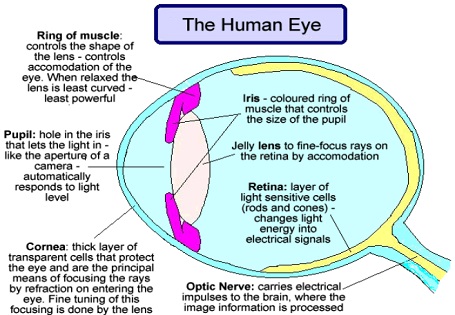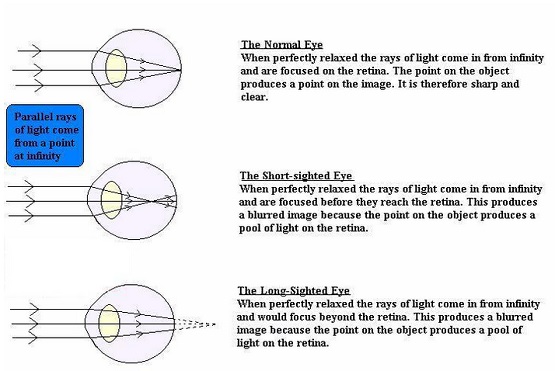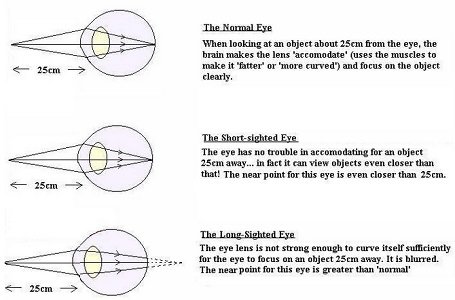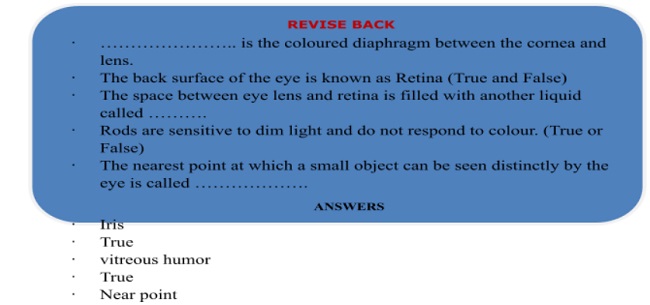
STRUCTURE AND WORKING OF HUMAN EYE
Light of Class 8
Human Eye
The human eye is one of the most sensitive sense organs of sight which enables us to see the wonderful world of light and colour around us. It is like a camera having a lens system and forming an inverted, real image on a light sensitive screen inside the eye. The structure and working of the eye is as follows :
Structure and Working of Human Eye
The eye is essentially a closed sphere into which light passes through a lens and strikes a light sensitive surface. A simplified anatomy of the eye is shown in the diagram below.

Parts of Eye
-
Cornea : It is the transparent spherical membrane covering the front of the eye.
-
Iris : It is the coloured diaphragm between the cornea and lens.
-
Pupil : It is the small hole in the iris.
-
Eye lens : It is a transparent lens made of jelly like material.
-
Ciliary muscles : These muscles hold the lens in position.
-
Retina : It is the back surface of the eye.
-
Blind spot : It is the point at which the optic nerve leaves the eye. An image formed at this point is not sent to the brain.
-
Aqueous humor : It is a clear liquid region between the cornea and the lens.
-
Vitreous humor : The space between eye lens and retina is filled with another liquid called vitreous humor.
NCERT solutions for class 8 Science prepared by pw will help you to solve your NCERT text book exercise.
You should also know that the Retina is the coating of the interior surface at the back of the eye. It consists of an array of light-sensitive receptors called rods and cones which convert the light energy into electrical signals. It plays the role of the film in a camera. Rods are sensitive to dim light and do not respond to colour. They allow us to see in dim light conditions. Cones are sensitive to bright light and colour (blue, red and green).
- When image is formed on the retina the image is inverted, real, and diminished. The ability of the eye to form an image on the curved surface of the retina is extremely important in human vision.
- The blind spot, located where the optic nerve meets the eye, contains no photo-receptors.
- The optic nerve transmits impulses to the brain. A crossover takes place. The optic nerve of each eye sends the information to the opposite hemisphere of the brain.
- One eye is usually dominant, controlling perspective. The use of two eyes (binocular vision) is necessary to obtain the correct perception of depth.
- In the eye, the image is formed on the retina by successive refractions at the cornea, the aqueous humor, the lens and the vitreous humor. Electrical signals then travel along the optic nerve to the brain to be interpreted. In good light, the yellow spot is most sensitive to detail and the image is automatically formed there.
- The brain is capable of making adjustments and corrections, so in spite of the poor optical qualities in the human eye (compared to other types of lenses and optical systems) no optical system yet devised can rival the superb qualities of human vision.
POWER OF ACCOMMODATION:
The images of the objects at different distances from the eye are brought to focus on the retina by changing the focal length of the eye-lens, which is composed of fibrous jelly-like material, can be modified to some extent by the ciliary muscles.
NEAR POINT AND FAR POINT:
The nearest point at which a small object can be seen distinctly by the eye is called the near point. For a normal eye, it is about 25 cm and is denoted by the symbol D.
With advancing age, the power of accommodation of the eye decreases as the eye lens gradually loses its flexibility. For most of the old persons aged nearly 60 years, the near point is about 200 cm and corrective glasses are needed to see the nearby objects clearly.
The farthest point upto which our eye can see objects clearly, without any strain on the eye is called the far point. For a person with normal vision, the far point is at infinity. You can refer NCERT solutions for class 8 science for this chapter for more detail.
Function of Iris and Pupil
- The iris automatically adjusts the student's size according to the amount of light it receives from its surroundings.
- If the light around us is very high (as during daylight), then the iris in the pupil contract (makes the pupil smaller) and thus reduces the amount of light entering the eye.
- If the amount of light around us is small (such as in a dark room or at night), then the iris increases the pupil (makes the reader larger) so that more light enters the eye. This is because we need to allow more light to enter the eyes when the outside light is dim so that we can see clearly.
VIEWING DISTANT OBJECTS:

N.B.: Refraction is only shown at the air/cornea boundary
VIEWING CLOSE-UP OBJECTS:

N.B.: Refraction is only shown at the air/cornea boundary

Frequently Asked Question (FAQs)
Q1. Give some sensory organs.
Ans. Some sensory organs of the human body are the eyes, ears, nose, tongue, and skin.
Q2. What are the parts of the human eye?
Ans. Parts of the human eye are:
- Sclera
- Cornea
- Iris
- Pupil
- Lens
- Retina
- Optic nerves
Q3. Define a blind spot?
Ans. The junction of the retina and optic nerve where no sensory nerve cells are found is known as a blind spot. No vision is possible in the blind spot.
Q4. What is the lens?
Ans. A lens is a transparent structure found behind the pupil.
Q5. What are the types of optic nerves?
Ans . Two types of optic nerves are:
- Cones
- Rods









